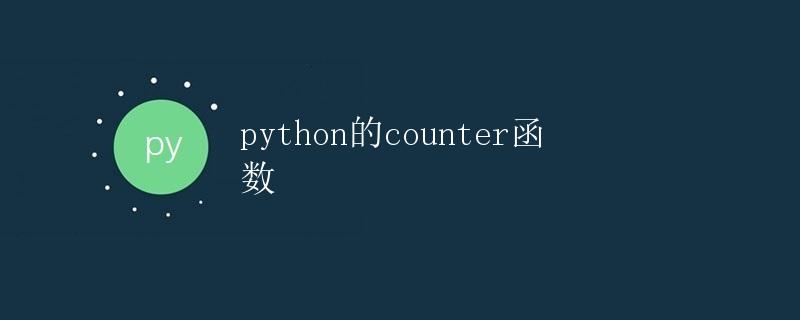Python的Counter函数

在Python中,Counter 是一个用来统计可迭代对象中元素个数的工具,它是 collections 模块中的一个类。Counter 返回的结果是一个字典,其中键是元素,值是该元素在可迭代对象中出现的次数。在本文中,我们将详细介绍 Counter 函数的用法和示例。
1. Counter函数的基本用法
首先,我们需要导入 Counter 函数:
from collections import Counter
接下来,我们可以用 Counter 来统计一个列表中元素的个数:
# 创建一个列表
lst = [1, 2, 3, 1, 2, 3, 4, 5, 1]
# 使用Counter统计列表中元素的个数
count = Counter(lst)
print(count)
运行结果:
Counter({1: 3, 2: 2, 3: 2, 4: 1, 5: 1})
从上面的示例可以看出,Counter 函数返回了一个字典,其中键是列表 lst 中的元素,值是该元素在列表中出现的次数。
2. Counter函数的高级用法
2.1 使用Counter统计字符串中字符的个数
除了列表,Counter 函数也可以用来统计字符串中字符的个数:
# 创建一个字符串
s = "hello world"
# 使用Counter统计字符串中字符的个数
count = Counter(s)
print(count)
运行结果:
Counter({'l': 3, 'o': 2, 'h': 1, 'e': 1, ' ': 1, 'w': 1, 'r': 1, 'd': 1})
2.2 使用Counter统计单词出现次数
我们也可以使用 Counter 来统计一个句子中单词的出现次数:
# 创建一个句子
sentence = "I love Python. Python is the best programming language."
# 将句子分割成单词列表
word_list = sentence.split()
# 使用Counter统计单词出现的次数
count = Counter(word_list)
print(count)
运行结果:
Counter({'Python.': 1, 'Python': 1, 'is': 1, 'the': 1, 'best': 1, 'programming': 1, 'language.': 1, 'I': 1, 'love': 1})
3. Counter函数的常用方法
Counter 函数还提供了一些常用的方法,用来操作统计结果。
3.1 elements方法
elements 方法返回一个迭代器,其中每个元素重复相应次数。可以通过循环来依次访问每个元素:
count = Counter([1, 2, 2, 3, 3, 3, 4, 4, 4, 4])
# 获取元素及重复次数的迭代器
elem_iter = count.elements()
for elem in elem_iter:
print(elem)
运行结果:
1
2
2
3
3
3
4
4
4
4
3.2 most_common方法
most_common 方法返回按照元素出现次数从高到低排序的元素列表。可以指定返回出现次数最多的前N个元素:
count = Counter([1, 2, 2, 3, 3, 3, 4, 4, 4, 4])
# 返回出现次数最多的2个元素
top_two = count.most_common(2)
print(top_two)
运行结果:
[(4, 4), (3, 3)]
3.3 update方法
update 方法用于从另一个可迭代对象中更新计数。如果传入的是字典,则计数将被重置为字典中的值:
count1 = Counter([1, 2, 2, 3, 3])
count2 = Counter([1, 2, 3, 4, 4, 4])
# 合并两个计数器
count1.update(count2)
print(count1)
运行结果:
Counter({1: 2, 2: 3, 3: 3, 4: 3})
4. 总结
本文介绍了 Python 中的 Counter 函数,包括其基本用法、高级用法以及常用方法。Counter 函数是一个非常方便的工具,可以帮助我们快速统计可迭代对象中元素的个数。在实际应用中,我们可以利用 Counter 函数轻松地做各种统计工作,提高编程效率。
 极客教程
极客教程